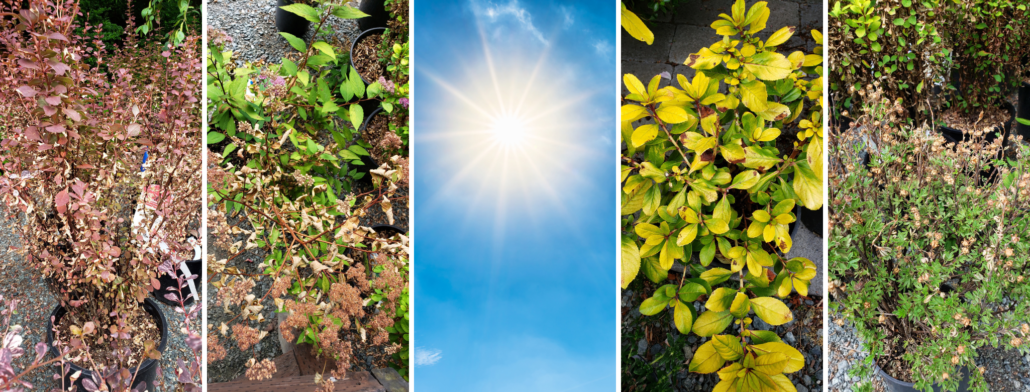Heat and Sun Damaged Plant Care

Is my sunburned plant dead?
The recent heat wave fried a lot of gardeners and a lot of plants too! Just because a plant’s leaves are scorched does not mean the plant is dead.
There are two ways plants can be damaged by the intense heat and strong sun. To understand what happens to plants in extreme sunlight and heat, consider what happens to humans. Strong sun makes us thirsty and we get sunburned. It is the same with plants!
CAUSES OF SUN STRESS ON PLANTS
Plants need water to live. Roots take water from the soil, and it is drawn up through the plant to the foliage. If the hot sun dries out the soil, and there is no water for the plant to take up, the leaves will wilt. If the situation persists the leaf tissue, and then the stem tissue, will be damaged. It will eventually turn a crunchy brown.
Just like strong sunshine fries your skin tissues with the UV rays, plant leaf cells can be damaged by UV light – especially when there is a sudden change in the intensity of light (like because of a massive heat wave, or when you move a plant from shade to sun). This damage doesn’t necessarily correlate to moisture availability; even plants with adequate water can have scalded leaves. Intense UV can even scald the bark (and along with it the vascular tissue that lies just underneath) of thin-skinned trees such as Japanese Maples. This can result in more extensive damage: whole stems and branches supported by that scalded section of bark can die, due to disruption of the water supply due to the damage to the vascular tissue.
WHAT TO DO ABOUT SUN DAMAGED PLANTS
Is it dead or will it revive?
If a plant was drought-stressed and has a few crunchy leaves, it may enough to cut back the damaged tissue and give it a deep drink. If the damage is extensive – lots of dead stems with crunchy tips – you may need to cut the plant back to the ground and hope it regrows. If you aren’t sure whether to cut or not, try bending the tips. If they are flexible, then leave them alone – they aren’t dead! If they snap off, they are dead and you can cut back until you reach flexible tissue. You can also try the scratch test: scrape the bark in a small area with your fingernail or a knife. If it is green, there is life. If it is brown, it is dead.
If you kept your plant well-watered during the heat but nonetheless its foliage is turning white, or brown and crunchy, the best solution is to remove the damaged leaves. If the burn is not from this heat wave, but because you recently moved your plant from shade to sun, you may want to leave the damaged foliage in place until the plant has had a chance to acclimatize. A gradual introduction to more intense sunlight is preferred; that gives the plant time to “toughen up” the cells to tolerate more sunshine.
In either case, make sure the soil is moist. Consider applying a dilute solution of an organic liquid fertilizer that is high in Nitrogen (like a 4-0-1 or 3-2-3 fish emulsion). Maintain even soil moisture and you should see signs of life returning in 2 – 4 weeks.
If after 6 weeks there is no sign of life, it could mean mean that the root system was damaged by desiccation and got too dry to regrow, or that damage to the plant tissues was too extensive to recover from. Then it is time to visit the nursery for a replacement!
CONIFERS ARE A SPECIAL CASE
The above treatment works for perennials, grasses, and deciduous woody shrubs. Conifers require different treatment. Most conifers will not back-bud. This means they will not make new growth on bare branches or the trunk. If you cut them back, you may be removing their growing tips, and can cause permanent damage. If your conifer has brown crunchy foliage, simply remove the dead foliage without cutting back any branches. Give the plant a steady supply of water and see if new needles appear in the next several weeks. If after 6 weeks, there is no sign of life, it may mean you need to visit your local nursery for a replacement plant.
